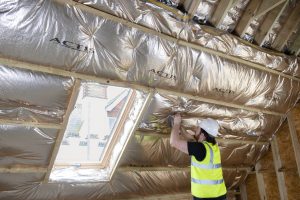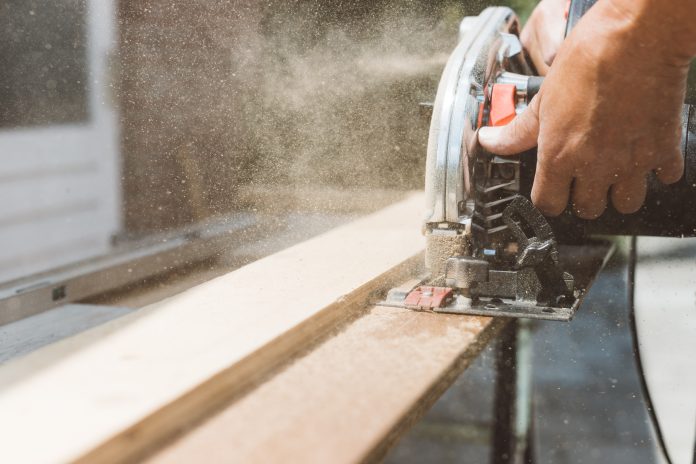Woodworking industries such as sawmilling, manufacture of composite boards, and carpentry are not taking measures to protect workers from the risks of wood dust exposure
The Health and Safety Executive will be undertaking site inspections at woodworking businesses to ensure proper measures are being taken to protect employees from wood dust exposure.
Woodworking industries risk high incidence rates of occupational ill-health caused by employee exposure to inadequately controlled respiratory sensitisers.
This includes dust from softwoods, hardwoods and composite materials in the workplace, such as sino-nasal cancer, occupational asthma and dermatitis.
The new wave of site inspections will run through 2023-24 and are supported by HSE’s Dust Kills campaign.
The campaign provides free advice to businesses and workers on the control measures required to prevent exposure to dust.
In the last year, 78% of woodworking businesses were not compliant
HSE carried out over a thousand inspections at woodworking sites across 2022-23 and found that over three quarters were not sufficiently protecting workers, resulting in 402 enforcement actions taken.
Particular areas of concern were general housekeeping (including dry sweeping of wood dust), Local Exhaust Ventilation (LEV) maintenance and thorough examination, selection of and face fit testing for Respiratory Protective Equipment (RPE), and health surveillance for exposure to wood dust.
There are 19,000 new cases of occupational respiratory issues each year
HSE’s head of manufacturing David Butter said: “Around 12,000 workers died last year from lung diseases linked to past exposure from work, and there are an estimated 19,000 new cases of breathing and lung problems each year, where individuals regarded their condition as being caused or made worse by work.
“Wood dust can cause serious health problems. It can cause asthma, which carpenters and joiners are four times more likely to get compared with other UK workers, as well as sino-nasal cancer. Our campaign aims to help businesses whose workers cut and shape wood to take action now to protect their workers’ respiratory health.”
The new inspections will ensure employees are aware of risks and precautions around wood dust exposure
Throughout 2023/24, inspectors will be looking for evidence that:
- employers have considered the control measures required to reduce workers exposure to wood dust
- workers understand the risks of exposure to wood dust
- effective control measures have been put in place to protect workers from harm
Inspectors will take enforcement action when necessary to make sure workers are protected.
David added: “Through visiting woodworking businesses, our inspectors are able to speak to a range of employers and look at the measures they have in place to comply with the guidance and protect workers from respiratory diseases such as occupational asthma and sino-nasal cancer.
“Our inspection initiative aims to ensure employers and workers are aware of the risks associated with the activities they do. They must recognise these dangers and manage these risks through reducing exposure.
“Employers need to do the right thing, for example, through completing a risk assessment, ensuring workers are trained, reducing exposure using LEV and using suitable RPE to protect workers, where required.”
You can find out more helpful information and guidance on lowering the risk of wood dust exposure here.
One option is to use insulation products that create no irritant dust when cut
Insulation specialist Actis suggests switching from using traditional, solid insulation products which create dust when cut to those which generate no irritants or dust whatsoever.
The revolutionary technology at the core of its new Eolis HC ensures installation is not only twice as quick as traditional alternatives, but will also transform the loft and barn conversion sector.
The two-in-one reflective insulation with an integrated vapour barrier will enable builders and roofers to reduce the number of steps required to achieve an impressive U-value as well as airtightness in roofs.
The Triplex technology on which Eolis HC is based is created from a number of layers of reflective films, each separated by a thin layer of fibre, trapping air between each section, thus boosting thermal performance.
This removes the need to cut insulation between each rafter, with all the tricky and dusty cutting that entails if using PIR board, thanks to the fact that it is thin enough to be used in low headspace zones whilst offering competitive thermal performance.

Actis UK and Ireland sales director Mark Cooper explained: “The beauty of this new technology is that it removes the time-consuming annoyance of cutting insulation to fit between timbers. It eliminates an entire step in the process. In a pitched roof it’s designed to work with a high or low resistance underlay. You just lay the Eolis HC across the warm side of the structure and cover it with rigid insulation and plasterboard or, to save even more time, use insulated plasterboard for the final finish.”
The dust-free nature of Actis insulation makes it many builder’s favourite
Adrian Neaves, whose coah house renovation was the subject of a George Clarke TV programme chose Actis in part because of its cleanliness.”I chose Actis rather than any other form of insulation for a number of reasons. One is the U-value, which is excellent. And I wanted it to be quick, clean, and easy to install. I didn’t need to wear a mask as there was no dust, and it was easy to cut and fit.”
And Northamptonshire builder Chris Brooks, who has been using Actis products for nearly twenty years, said: “It’s incredibly clean and there’s no dust. I always love it when an architect specifies Actis. And in fact, if they specified PIR board instead I’d encourage them to look at the benefits of Actis. It’s so much nicer to use when you’re installing it.”
Eolis HC is the first major product to be launched by Actis in a decade – with its existing Hybrid range also offering a clean, easy and dust free way of counteracting thermal bridging.
The range includes flexible honeycomb insulation Hybris, insulating vapour control and breather membranes H Control Hybrid, Boost R Hybrid and Boost R Hybrid Roof.
You can read more about Actis’s range of products here.










![[VIDEO] Behind-the-scenes video of M25 orbital bridge demolition released Tru7 Group has released footage of the M25 orbital bridge demolition, which reopened eight hours ahead of schedule](https://www.pbctoday.co.uk/news/wp-content/uploads/2024/03/image-from-tru7-video-218x150.png)






